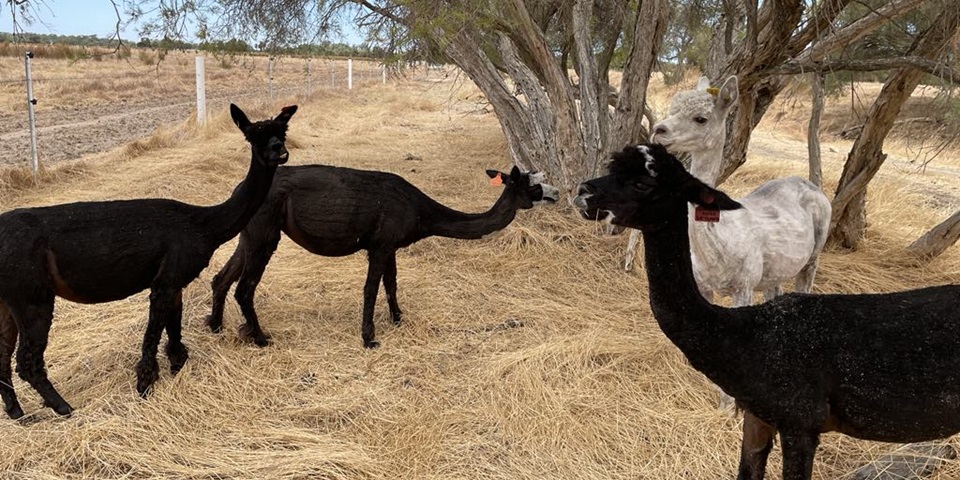student story
Alpacas: Why you shouldn't overlook opportunities to work with camelid livestock

Whilst not the first animal that comes to mind for many people when “Australian Livestock” is mentioned, these cute camelids provide exciting opportunities for those in the field of agricultural science.
Article by Storm Mackenzie (Agricultural Science student)
Aside from their adorable looks, alpacas provide fleece similar to sheep wool but with higher absorbency, a soft cashmere feel without need for extra processing, and without that oily lanolin coating. Fleece quality is a significant factor in alpaca farming, but alpacas also make excellent herd guards and are also used as pets on many hobby farms across the country. While the meat industry currently doesn’t cater well for alpaca farmers due to limited abattoirs with the ability to process alpaca meat, the future may see that change as alpaca populations and enterprises grow across Australia.
Alpaca farming is a lesser-known pathway with great potential for interested agricultural science students. Alpaca basics are touched on through the general livestock units. Students are encouraged to learn more through farm placements, research and case study units, and utilising workshops provided by external associations such as WA Alpaca Youth and the Australian Alpaca Association. Memberships with the Australian Alpaca Association provide access to shows, handling workshops, camps and training, with those under 26 years old being able to participate in the Young Paraders Stockmanship program and further learning opportunities. MASSA (Murdoch Agricultural Science Students Association) and other livestock interest groups sometimes share further workshops available to students, so being proactively involved in these groups can benefit students.
Alpacas are remarkable creatures, with many unique points setting them apart from other Australian livestock. Pathways in genetics, breeding and management could open the door to career options improving wool properties (e.g. micron, fibre length), health (e.g. resistance to common parasites, improved reproduction, limb conformation, etc), selection for behaviour and temperament, developing breeding values and genotyping. Improvements can be made in the industry including developing processing plants for alpaca meat; developing best-practice management strategies that improve animal health and welfare; shearing and other aspects of alpaca husbandry. Research, fleece processing and developing new market for alpaca products - the possibilities are endless.
What are Alpacas?
Alpacas are a species of camelid originating from South America. A part of the same family as guanacos, llamas and vicunas, alpacas are long-legged, long-necked mammals covered in wool, similar to sheep. There are two types of alpaca: the huacaya and the suri. The key differences between the two lay in their coats. While they can be bred together, most of the time, this leads to a poor-quality fleece for both types rather than a best-of-both-worlds situation. Huacayas are the more common type and have a fluffier appearance, with body fibre growing directly outwards, similar to Merino sheep. In contrast, a suri’s fleece drapes down from a centre part in a curtain of silky, locking fleece fibres.
How to get Involved with Alpacas at University
Aside from extracurricular activities, a great way to include alpacas in your university degree is through choosing an Alpaca farm for practical units. Sophie at Banksia Park Alpaca Stud has hosted students for placements, providing an excellent learning opportunity that can count towards your degree. Students get the chance to help directly with many aspects of farming including shearing, drenching, halter training and float training. Sophie also provides more information beyond the basics of the farm and has a wealth of knowledge (and an amazing memory – she recognises and remembers every alpaca by name). Banksia Park is just one of a handful of alpaca studs in the greater Perth area where students can find learning opportunities.
Richard Dixon Memorial Scholarship
Richard Dixon was awarded a Bachelor of Veterinary Sciences, Master of Veterinary Science and Master of Science. His impact spanned multiple fields of veterinary and agricultural sciences, including veterinary radiology (a novel field at the time), surgery, orthopaedic disorders of juvenile animals (promoting hip dysplasia control in Australia and introducing assessment of coxofemoral joints for laxity through luxoid projections), private practice, brachytherapy (becoming one of the first to move the field of brachytherapy to animals), and as an alpaca stud breeder with a vast array of knowledge in health, nutrition and husbandry. Richard was a key facilitator of the rigorous monitoring program developed in Australia for the Johnes Disease outbreak in the mid-1990s1,2. In memory and recognition of Dr Richard Dixon's contribution to the alpaca industry, the AAA awards a yearly scholarship to a senior veterinary science student.
- Allan G. Richard T. Dixon, BVSc, MVSc, MS: Diplomate 1965. Veterinary Radiology & Ultrasound. 2009; 50 (1): 130.
- Ridge SE, Harkin JT, Badman RT, Mellor AM, Larsen JW. Johne’s disease in alpacas (Lama pacos) in Australia. Aust Vet J. 1995; 72 (4): 150-153. doi: 10.1111/j.1751-0813.1995.tb15040.x
student story
Alpacas: Why you shouldn't overlook opportunities to work with camelid livestock
Posted on
Topics